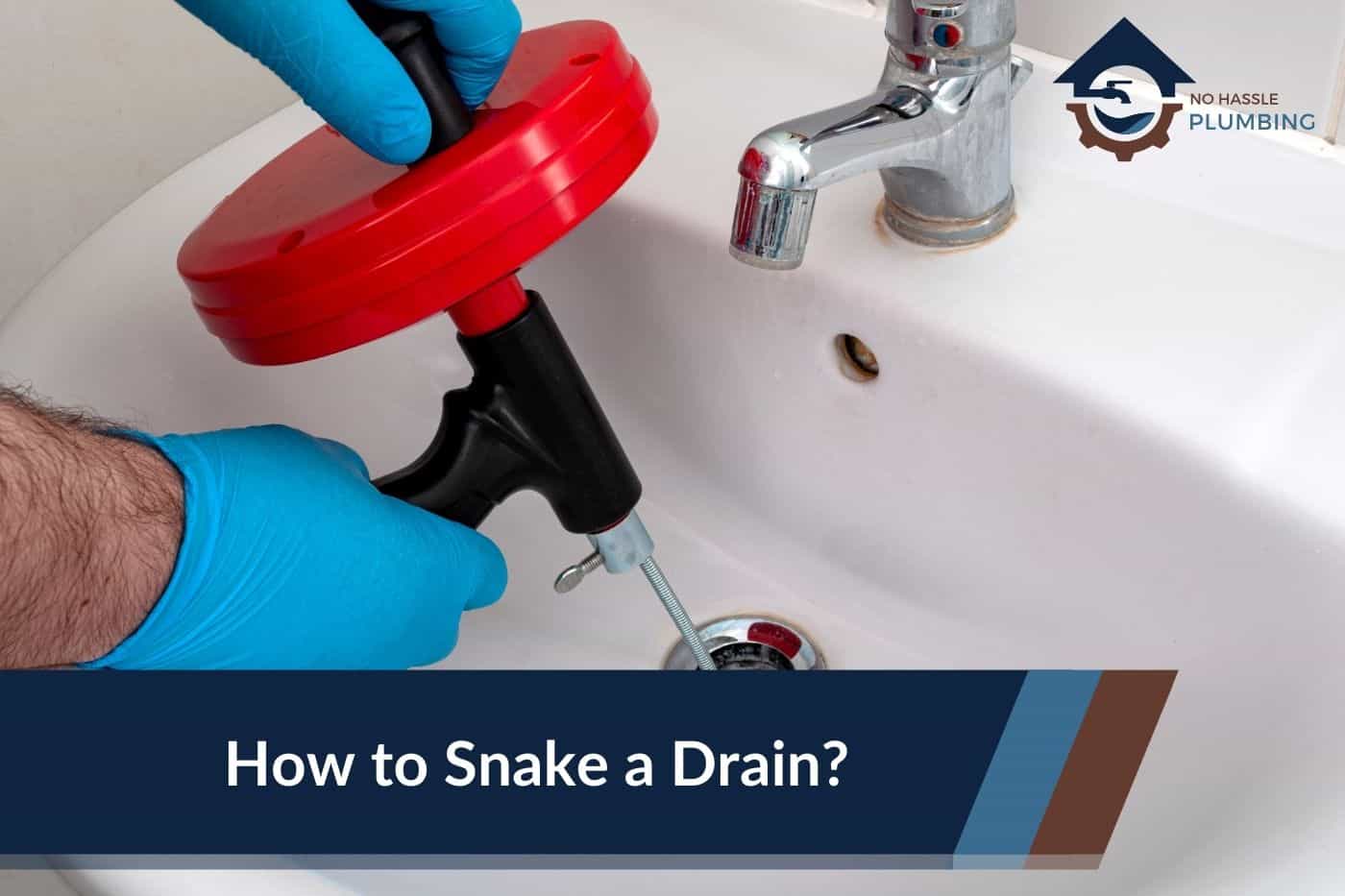Clearing a stubborn drain clog is a common household challenge, and one effective solution is using a drain snake, also known as a plumber’s snake or auger. This versatile plumbing tool can help you tackle blockages in sinks, showers, toilets, and other pipes, allowing for a smoother flow of water and preventing plumbing issues.
In this article, we will take a more detailed look at how to use a plumber’s snake correctly, the best way to snake a sink, shower, or toilet drain, when snaking a drain is necessary, where to buy a drain snake and tips for troubleshooting snaking a clogged drain.
Contents
- What is a Plumbing Snake?
- When to use a snake to unclog a drain?
- Project Overview: Snaking a Clogged Drain
- How to Use a Drain Snake?
- How to Use a Plumbing Snake on Shower or Bathtub Drain Clogs?
- How to Use a Toilet Snake?
- How to Use a Sewer Snake?
- What Tips Should I Be Aware Of to Remove the Clog?
- Where to buy a plumbing snake?
- When to Call a Plumber to Remove the Clog?
What is a Plumbing Snake?
A drain snake, also known as a plumber’s snake or auger, is a specialized plumbing tool designed to clear clogs and blockages in drains and pipes. It consists of a long, flexible cable with a corkscrew-like auger head at one end.
When to use a snake to unclog a drain?
If you have an obstruction, there are a few signs that indicate it’s time to use a snake. Here are some common signs to look out for.
- Slow-draining water in your sink, garbage disposal, bathtub, or shower drain is a sure sign that a clog is forming.
- Unpleasant odors coming from your sink or floor drain are often caused by a clog that’s causing sewage to back up.
- If you have more than one blocked drain in your home, it’s a sign that your plumbing problems are likely in the main drain line. Using a drain auger can help remove clogs from the main sewer line.
As removing p-traps and running an auger is a time-consuming task, we recommend you try using baking soda and vinegar or a chemical drain cleaner from your local hardware store first. Most localized clogs are found in the trap, and can often be broken up easily.
Project Overview: Snaking a Clogged Drain
Before you start, gather the necessary tools and equipment. You’ll need the following equipment.
- Plumber’s snake drain
- Rubber gloves
- Safety Glasses
- Bucket
- Plug Wrench
- Old Towels or Rags
- Paper Towels
A typical clogged toilet or drain will take 15 – 25 minutes to clear using a plumbing snake. However, this estimate will increase if you are dealing with stubborn or multiple clogs.
| SKILL | COST | ESTIMATED TIME |
| Moderate | Purchase: $20-80 (Manual) or $200+ (Electric) Rental: $45-70/day (Electric) | Less than 1 hour |
How to Use a Drain Snake?
To clear your clogged drains with a snake, you will need to do the following.
- Remove P-Trap
- Insert & Extend Cable
- Rotate Cable to Catch Blockage
- Retract Cable
- Clean Plumbers Snake
- Reassemble the Pipes & Test Drain Flow
- Repeat
1. Remove the P-Trap
The first step is to locate and remove the P-trap underneath your sink. A P-trap is a curved pipe connected to your drain, and its purpose is to create a water seal to prevent sewer gasses from entering your home from the main drain line.
As the trap holds standing water, it’s a good idea to place a bucket (and an old towel) below it before you start. Remove the p-trap by using a wrench to loosen the slip nuts, then unscrew the sink drain and remove the collected water and any visible debris, such as hair or soap scum.
When dealing with shower drains, use a flat-head screwdriver to carefully pop off any screens or drain cover and then use a plug wrench to turn the drain counterclockwise to remove it.
For tub drains, you need to access the trap through the overflow portion of the drain. As you’ll need to navigate the drain trap or trap arm, an electric snake will be more effective than a manual snake.
2. Insert & Extend Cable
Insert the end of the snake (also called the auger head) a few inches into the drain opening, then turn the crank handle clockwise while gently pushing the cable into the drain.
Keep turning the handle slowly to allow the auger cable to descend down the drain pipe. You may occasionally need to crank a little harder or give the snake a wiggle to help you get around any tight corners.
Keep going until the snake begins to feel resistance, which is likely the source of the clog.
3. Catch the Blockage
Once you have found the blockage, tighten the thumbscrew and push the snake cable a few inches beyond it for maximum contact. Gently rotate the snake in a counterclockwise direction and move it back and forth – this will either allow the rotating tip to break up the clog or, if it’s a solid chunk, pierce the mass so you can hook the clog and pull it up slowly.
4. Retract the Cable
After you hit the clog, pull the snake back out of the drain slowly without any rotation. If you rotate the cable while retracting it, you may lose the clog.
5. Clean the Plumber’s Snake
Once you’ve pulled the snake out of the drain, clean the tool of any material hooked by the auger tip using a paper towel or cloth, then carefully discard it in the bucket.
6. Test the Drain Flow
If you are sure you have removed all the stubborn clogs, then reassemble the sink-trap and drains, and tighten the plastic nuts by hand. At this point, it is best to flush the drain with hot water for a while to help break up any remaining residue.
Turn on the cold water to check if the blockage has been cleared successfully. If everything is running smoothly, congratulations!
7. Repeat
If your system continues to back up then there may be more clogs deeper in your pipes. Repeat the process until you’ve removed all the blockages.
How to Use a Plumbing Snake on Shower or Bathtub Drain Clogs?
As most shower or bathtub p-traps are not easily accessible, start by removing the shower drain (for showers) and insert the snake into the drain hole. For baths, insert the augur through the overflow hole.
Extend the snake as you would for sink drains, rotating it to get around pipe bends. Once you identify the blockage, rotate the auger to break up and catch any debris and remove. Repeat until you have cleared the obstruction, flush the pipes with hot water and then reconnect the cover.
How to Use a Toilet Snake?
For toilet drain clogs, ensure you are using a toilet or closet auger – these snakes have a protective rubber sleeve that helps prevent the toilet auger from scratching your porcelain. While it is possible to use a regular snake, we wouldn’t recommend it as it is likely to cause damage to your toilet bowl.
Using a toilet snake works in exactly the same way as our instructions above for a bathroom or kitchen sink drain. Insert the auger head into your toilet bowl, and extend the cable until you reach the obstruction. Rotate to help break it up, and then retract the cable and clean up.
How to Use a Sewer Snake?
For a clogged sewer line, we would highly recommend contacting a professional plumber, as sewer line clearance often requires specialist equipment to determine the cause, and if any repair work is required (in addition to clearing the clog).
What Tips Should I Be Aware Of to Remove the Clog?
If you’re planning to unclog a sink by snaking the drain, here are some home improvement tips to help you get the job done effectively:
- To avoid damaging your pipes, start with a small cable and work up to thicker cables as you gain experience.
- Rotate the cable slowly and avoid using excessive force, as this can cause the cable to break or damage your pipes. If the cable gets stuck, avoid yanking it and instead try rotating it in the opposite direction.
- Always place a bucket underneath the P-trap before removing it to catch any debris or water that may spill out.
- Dispose of any debris that you remove in the trash or compost, rather than flushing it down the toilet or sink.
- After clearing the clog, run water down the drain to make sure that it’s flowing smoothly.
- Prevent clogs from forming in the first place by using a debris or hair trap and clean your drains regularly with baking soda and hot water.
- Wear rubber gloves and safety goggles as anything you remove in the snaking process is likely nasty!
By following these tips, you can successfully clear your clogged pipes with a plumber’s snake and avoid damaging your plumbing system.
Where to buy a plumbing snake?
Plumber’s snakes are readily available online at retailers like Amazon, Lowe’s or Home Depot, or at any local or national hardware store.
How Much Does A Drain Auger Cost?
Manual hand-operated drain augers are relatively affordable and commonly range from $20 to $80. Electric augers tend to be more expensive, with prices starting around $200 and potentially reaching several hundred dollars for high-end models.
When to Call a Plumber to Remove the Clog?
You should consider calling a plumber to remove a drain clog when you’ve attempted DIY methods like using a plunger or a plumbing auger, but the clog persists or returns shortly after clearing. Additionally, if you notice signs of more significant plumbing issues such as slow drainage in multiple fixtures, unpleasant odors, water backups, or repeated clogs, it’s best to consult a professional plumber.
How much does it cost for a Plumber to snake a drain?
On average, homeowners can expect to pay between $100 to $300 for professional drain snaking services. The actual cost can vary significantly depending on factors such as the complexity of the clog, location, and the specific plumber you hire which we detail in our article on “How much does it cost to snake a drain?”.

